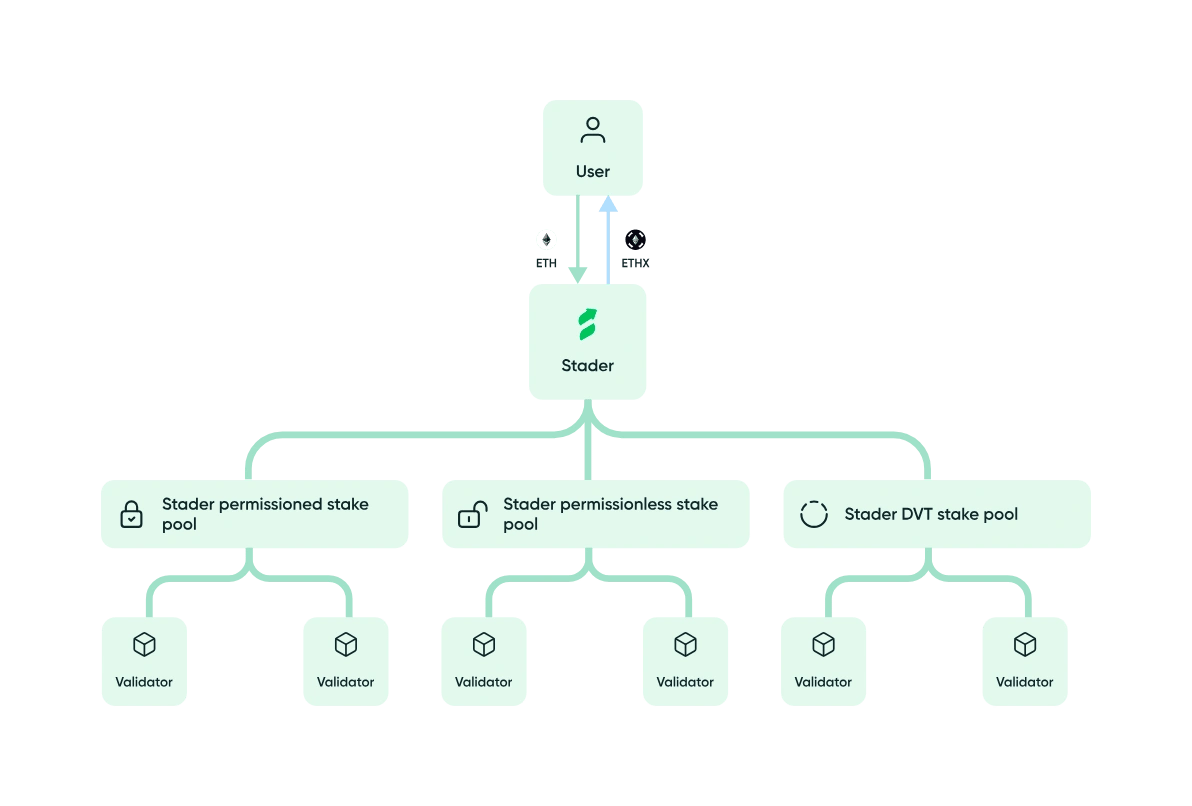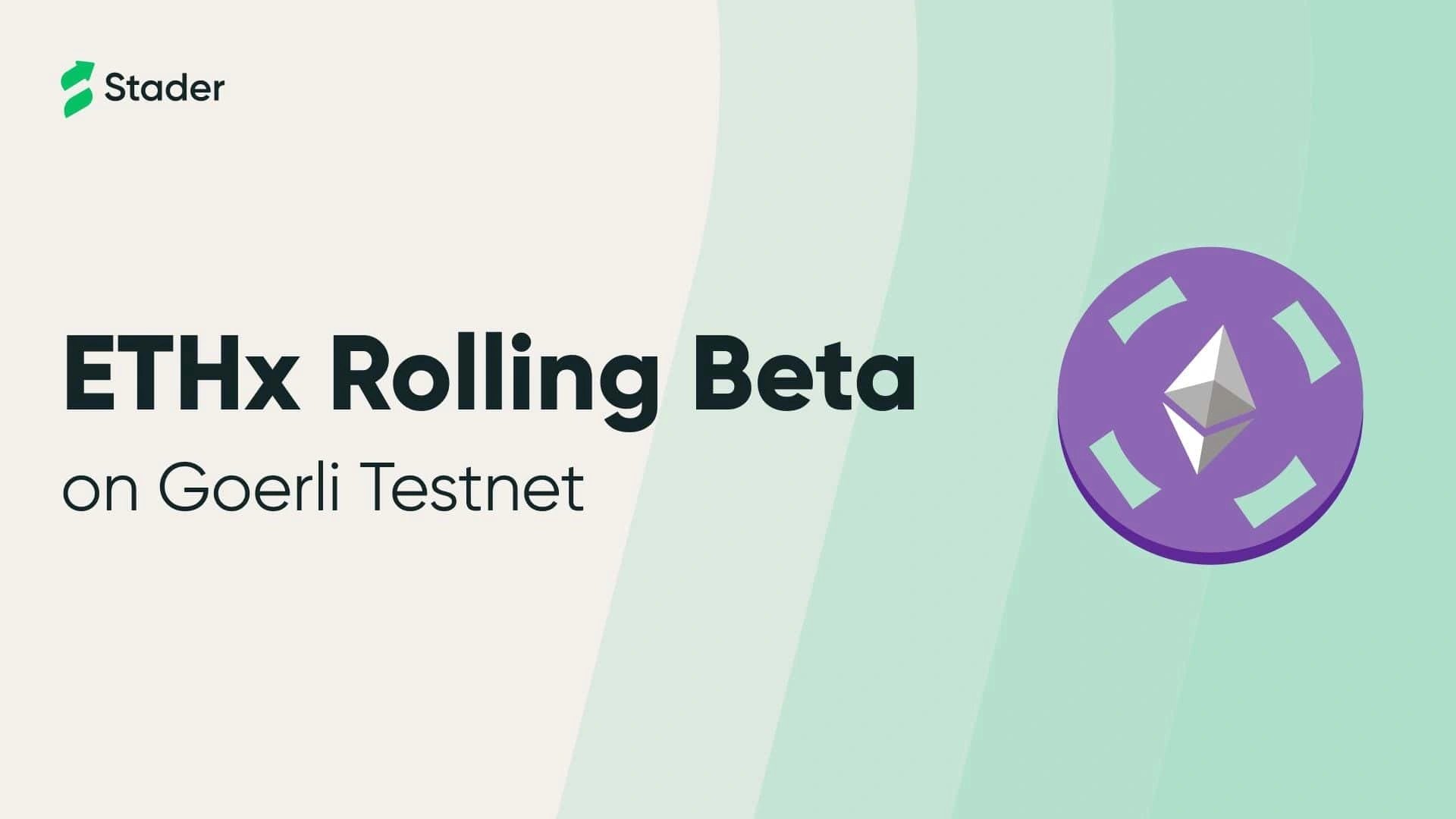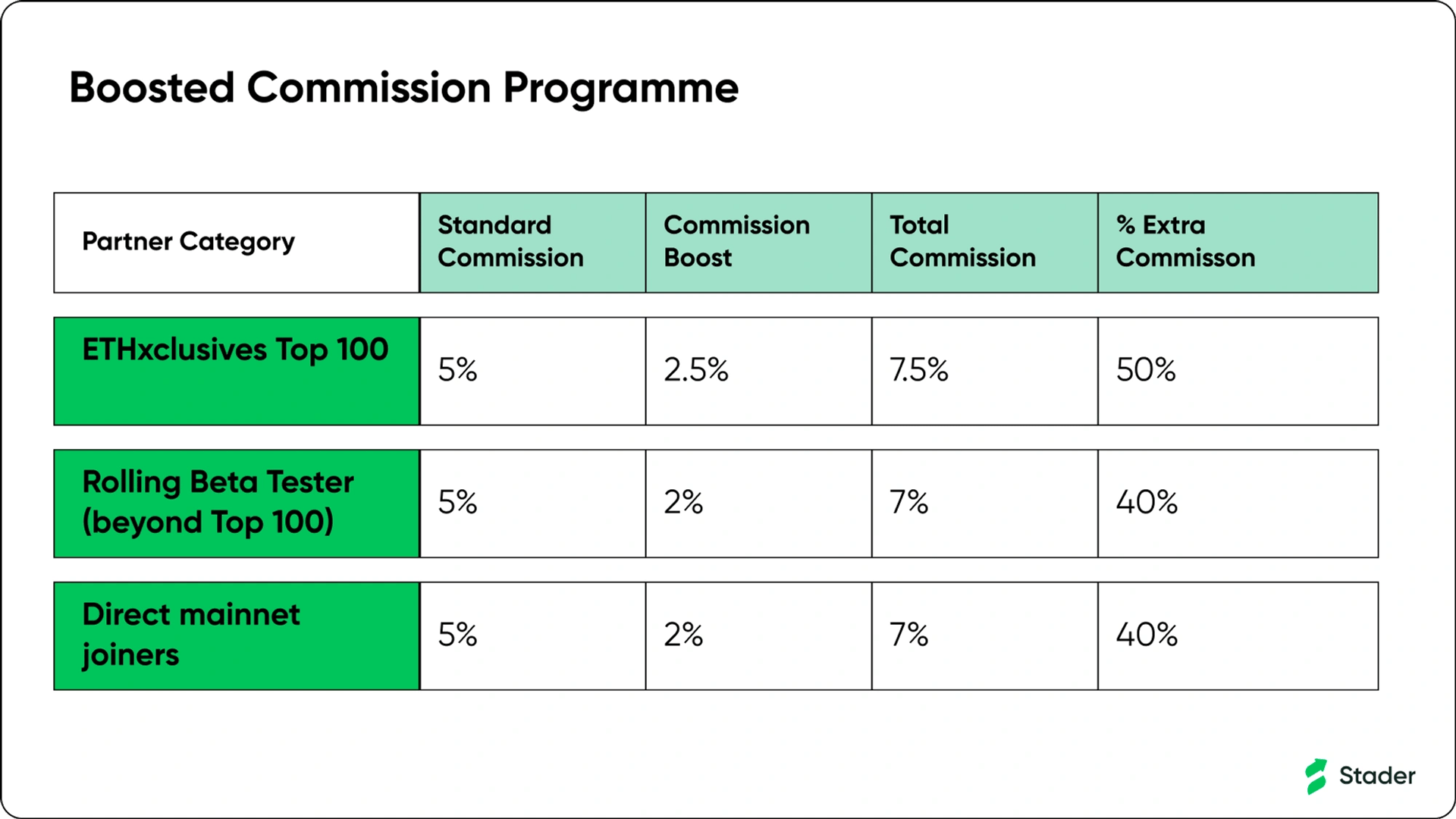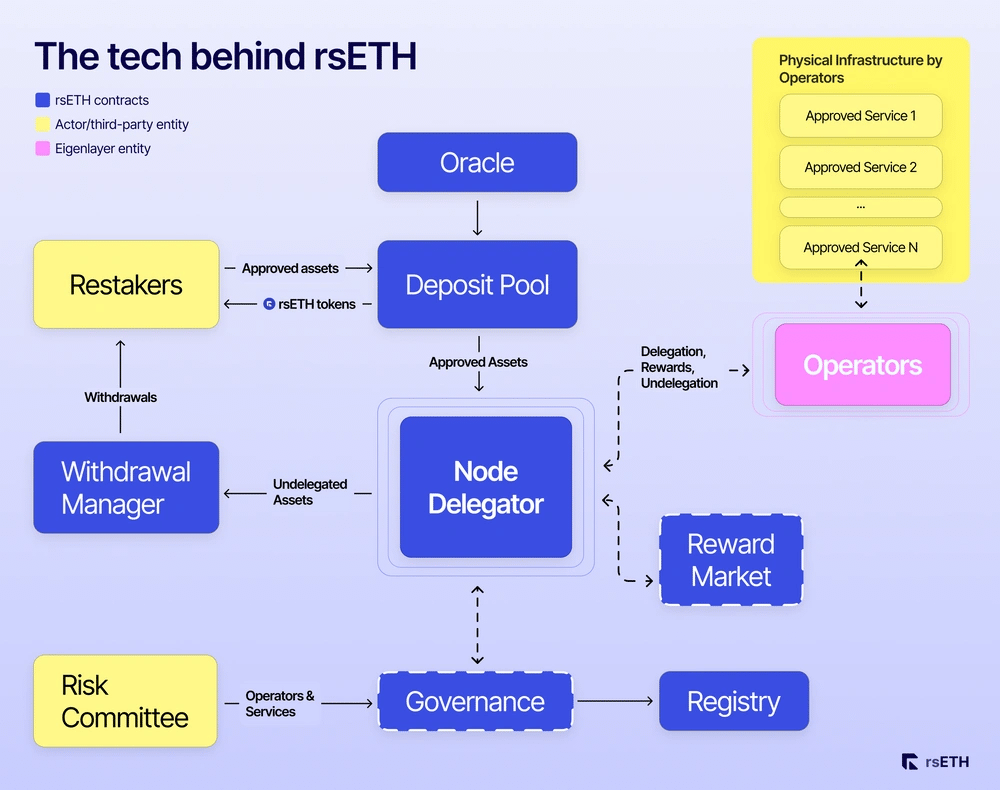위키 구독하기
Share wiki
Bookmark
Stader Labs
Stader Labs
Stader Labs(스테이더 랩스)는 스마트 계약(스마트 컨트랙트) 기반의 비보관형 스테이킹 플랫폼으로, 스테이킹 솔루션 활용을 간소화하도록 설계되었습니다. 이 플랫폼은 다양한 지분 증명(PoS) 네트워크를 위한 필수적인 미들웨어 인프라 역할을 하며, 소매 암호화폐 사용자, 거래소 및 수탁자를 지원합니다. [1]
개요
2021년 4월에 Sidhartha Doddipalli(시다르타 도디팔리)와 Amitej Gajjala(아미테지 가잘라)가 설립한 Stader Labs는 공개 블록체인(블록체인) 네트워크 전반에서 효과적인 자산 스테이킹 관리를 위해 맞춤화된 탈중앙화 금융 프로토콜 및 솔루션을 만드는 데 전념하고 있습니다. Stader의 핵심 혁신은 유동적 스테이킹(리퀴드 스테이킹)으로, 사용자가 스테이킹된 자산을 나타내는 토큰을 생성할 수 있는 메커니즘입니다. [1]
이러한 토큰은 스테이킹 보상이 누적됨에 따라 가치가 상승하여 스테이킹을 통한 네트워크 보안과 탈중앙화 금융 (DeFi)(디파이) 분야 모두에 참여를 장려합니다. Stader는 여러 블록체인 네트워크에서 평판이 좋은 감사자가 수행하는 지속적인 코드 검토, 광범위한 테스트 및 외부 감사를 포함하는 효율적인 보안 접근 방식을 사용합니다. 또한, 플랫폼은 다중 서명 (Multi-sig)(멀티 시그) 관리 계정을 구현하여 스마트 계약(스마트 컨트랙트) 매개변수의 무결성을 보호하고, 안전한 유동적 스테이킹 솔루션을 제공하고자 합니다. [1][2]
자금 조달
2022년 1월, Stader Labs 팀은 Three Arrows Capital이 주도하는 투자 라운드에서 1,250만 달러를 조달하여 회사 가치를 4억 5천만 달러로 평가받았습니다. Blockchain.com, Accomplice, GoldenTree Asset Management, Accel 및 기타 투자자들도 자금을 제공했습니다. [28]
2021년 10월, Stader Labs는 Pantera Capital이 주도하는 시드 라운드에서 400만 달러를 조달했습니다. Coinbase Ventures, True Ventures, Jump Capital 및 Ledgerprime도 이 라운드에 참여했습니다. [27]
SD 토큰
Stader (SD) 토큰은 Stader 생태계의 가치 축적 및 거버넌스 토큰 역할을 합니다. 총 공급량이 1억 5천만 개로 제한된 ERC-20 표준을 준수합니다. [9][26]
토큰 분배
SD 토큰은 다양한 부문에 할당되며, 각 부문은 전체 공급량의 특정 비율과 출시 일정을 가지고 있으며, 거버넌스 결정에 따라 달라질 수 있습니다.
- 보상 + Farming (0.36%): 이 부문의 분배 일정은 거버넌스를 통해 결정되는 개별 보상 프로그램에 따라 달라집니다.
- 팀 + 자문위원 (0.17%): 6개월의 클리프 기간 후 36개월에 걸친 선형적 해제 기간이 있습니다.
- 프라이빗 세일 (0.17%): 토큰은 토큰 생성 이벤트(TGE)에서 0-5% 범위 내에서 해제되며, TGE 이후 36개월에 걸친 선형적 해제 일정을 따릅니다.
- DAO 펀드 (0.15%): 이 부문의 분배 세부 정보는 아직 확정되지 않았으며 거버넌스 결정에 따라 달라집니다.
- 에코시스템 펀드 (0.11%): 초기에는 이 부문 토큰의 0.5%-1.5%가 TGE에서 해제되며, 나머지 해제는 거버넌스 결정에 따라 달라집니다.
- 퍼블릭 세일 (0.04%): 이 부문에는 두 가지 옵션이 있습니다. 옵션 1은 300만 개의 공급량으로 $4.50에 토큰을 판매하며, 40일간의 락업 기간 후 2022년 3월부터 7월까지 매월 20%씩 해제됩니다. 옵션 2는 300만 개의 공급량으로 $3.33에 토큰을 판매하며, 3개월간의 락업 기간 후 2022년 4월부터 12월까지 격월로 20%씩 해제됩니다. [9]
토큰 유틸리티
- 거버넌스 및 투표: SD 토큰 보유자는 다양한 거버넌스 프로세스에 적극적으로 참여하여 보상, 검증자 선정 기준, 프로토콜 확장 등과 관련된 의사결정에 영향을 미칠 수 있습니다.
- 스테이킹 보상: SD 토큰 보유자는 토큰을 스테이킹하여 거버넌스 결정에 따라 프로토콜 수수료의 일부를 스테이킹 보상으로 받을 수 있습니다.
- 유동성 마이닝: 참여자는 탈중앙화 거래소(DEX)에서 SD 유동성을 제공하여 유동성 마이닝에 참여할 수 있으며, 이를 통해 에코시스템에 의해 관리되는 SD 인센티브를 받을 수 있습니다.
- 우선 순위 위임: 스테이킹된 SD 토큰의 양은 검증자에 대한 우선 순위 위임에 영향을 미치며, 스테이킹된 수량에 따라 특정 이점을 제공합니다. 이러한 우선 순위는 거버넌스 프로세스를 통해 결정됩니다. [9]
ETHx
ETHx는 분산성, 확장성 및 복원력을 위해 설계된 다중 풀 아키텍처를 도입합니다. 이 아키텍처는 누구나 노드를 운영하고 일관된 성능을 제공하는 큐레이팅된 검증자를 운영할 수 있도록 허가형 및 비허가형 풀을 포함합니다. 분산 검증자 기술(DVT)이 더 안정화됨에 따라 ETHx는 향후 전용 DVT 기반 스테이킹 풀을 도입하여 진화하는 ETH 스테이킹 생태계에 적응할 것입니다. [3]

2023년 7월 10일 메인넷에서 출시된 ETHx 토큰은 Stader의 ERC-20 리퀴드 스테이킹 토큰으로, 사용자들이 스테이킹된 ETH 자산을 활용하면서 스테이킹 보상을 계속해서 받고 확장되는 DeFi 생태계에 참여할 수 있도록 합니다. ETHx는 지속적인 스테이킹 보상을 보장하여 이더리움 보유량을 증가시키는 동시에 dApp과 통합하여 사용자가 추가적인 수익 농사 및 대출 기회를 탐색할 수 있도록 합니다. 또한 ETHx는 이더리움의 분산화 노력에 기여하여 네트워크의 확장성과 복원력을 높입니다. [3][7]
ETHx 거버넌스
ETHx 거버넌스는 커뮤니티 멀티시그(Community multisig), 매니저 멀티시그(Manager multisig), 그리고 운영자(Operator) 세 주체에 의해 유지됩니다. 이들 주체는 ETHx 생태계 내에서 투명성, 책임성, 그리고 균형 잡힌 의사결정 및 운영 방식을 보장하기 위해 협력합니다. Stader의 미래 비전의 일환으로, 온체인 거버넌스가 점진적으로 도입되어 Stader의 거버넌스 토큰인 SD와 ETHx 보유자들이 프로토콜 변경을 제안하고 구현할 수 있도록 권한을 부여하여 분산된 의사결정과 포용성을 증진할 것입니다. [4]
ETHx 스테이킹
ETHx는 사용자에게 ETH 자산을 스테이킹하면서 유동성을 유지하는 이중적인 이점을 제공하는 새로운 이더리움 스테이킹 방식을 도입합니다. 이 과정을 간략하게 설명하면 다음과 같습니다.
- 예치 및 토큰 발행: 사용자가 ETHx 스테이킹 계약에 이더리움을 예치하면 프로토콜은 사용자에게 동일한 양의 ETHx 토큰을 발행합니다. 이 토큰은 사용자의 스테이킹된 이더리움을 나타내는 유동적인 표현으로, 사용자는 스테이킹 보상의 잠재력을 포기하지 않고도 자산에 대한 통제력을 유지할 수 있습니다.
- 멀티풀 아키텍처: 예치 후 Stader의 스테이킹 매니저가 멀티풀 아키텍처를 사용하여 관리합니다. 사용자의 스테이킹된 이더리움은 권한 없는 노드 운영자 풀과 권한 있는 노드 운영자 풀에 지능적으로 분산됩니다. 이러한 설계는 확장성과 분산성을 보장할 뿐만 아니라 스테이킹된 자산의 수익 잠재력을 최적화합니다.
- 노드 네트워크 및 보상 생성: 이러한 풀에서 나온 이더리움은 ETHx 노드 네트워크(ETHx Node Network)로 전달됩니다. ETHx 노드 네트워크는 프로토콜의 스테이킹 계약과 복잡하게 연관된 분산형 이더리움 노드 네트워크입니다. 이러한 노드는 이더리움 비콘 체인에 필수적인 중요한 검증 작업을 수행합니다. 이러한 노드가 수행하는 기능은 스테이킹 보상 생성으로 이어집니다.
- 누적된 보상 및 가치 상승**: 이러한 노드가 보상을 생성함에 따라, 이는 누적되어 이더리움에 대한 ETHx의 환율 상승에 기여합니다. 이러한 독창적인 성장 메커니즘은 ETHx 토큰의 가치가 시간이 지남에 따라 지속적으로 상승하여 스테이킹된 이더리움에서 얻은 스테이킹 보상을 반영하도록 합니다.
롤링 베타 출시
권한 없는 노드 운영자를 위한 ETHx 롤링 베타는 2023년 3월 27일 Görli 테스트넷에서 첫선을 보였습니다. 가장 인기 있는 ETH 테스트넷 중 하나로 알려진 Görli 테스트넷은 출시 시점에 인출을 테스트하기 위한 Shapella 업그레이드를 거쳤으며, 이는 ETHx 롤링 베타에 대한 이상적인 테스트 환경을 조성했습니다. 권한 없는 노드 운영자를 위한 ETHx 롤링 베타는 두 단계로 구성되었습니다. [8]

출시 인센티브
ETHx 메인넷 출시를 맞이하여 Stader는 ETHx 스테이커와 ETHx 노드 운영자 모두를 위한 출시 인센티브를 설정했습니다. [5]
ETHx 스테이커
ETHx 스테이커를 위한 인센티브는 런칭 기간 동안 Stader에 이더리움 토큰을 스테이킹한 모든 참여자에게 혜택을 제공하도록 설계되었습니다. 이 프로그램은 보상에 대한 무제한 50% 증가라는 독특한 기능을 제공했습니다. 참여자는 일일 스테이킹 금액과 프로토콜의 일일 APR을 기반으로 동적으로 계산되는 보상을 얻을 수 있었습니다. 이 향상된 보상 구조를 통해 사용자는 10% 수수료 공제 후 수익의 50% 증가를 얻을 수 있었습니다. 이 프로그램은 최소 스테이크 요구 사항이나 보유 기간 없이 누구에게나 개방되어 포괄성과 접근성을 보장했습니다. 보상은 매일 계산되었으며 런칭 기간 동안 집계되었고, 런칭 기간 종료 후 5일 이내에 지급되었습니다. [6]
ETHx 노드 운영자
ETHx가 출시한 ETHx 노드 운영자를 위한 인센티브 프로그램은 출시 기간 동안 Stader 네트워크에서 권한 없는 ETHx 노드를 운영하는 개인에게 보상을 제공하기 위해 도입되었습니다. [19]
부스트 커미션
부스트 커미션 프로그램은 초기 ETHx 노드 운영자들에게 인센티브를 제공하여 메인넷에서 1년 동안 부스트된 커미션을 받을 수 있도록 설계되었습니다. 자격을 얻으려면 노드 운영자는 ETHx 메인넷 출시 한 달 이내에 참여하고, Stader 메인넷 네트워크에 노드를 성공적으로 등록하고, 노드에 검증자를 추가해야 했습니다. 자격을 갖춘 노드 운영자의 처음 4개 검증자는 성과에 따라 매달 지급되는 부스트된 커미션을 받을 수 있었습니다. 이 커미션 부스트는 출시 월에 생성된 노드 운영자당 처음 4개의 검증자에게 적용되어 초기 참여를 장려하고 성공적인 노드 운영을 보상했습니다. [20]

$SD 상위 보상 풀
$SD 상위 보상 풀은 두 번의 롤링 베타 단계 중 어느 하나에서 테스트넷(https://iq.wiki/wiki/testnet) 노드를 설정하여 적극적으로 참여한 모든 커뮤니티 회원이 이용할 수 있었습니다. 에어드롭 자격을 얻으려면 참가자는 ETHx 메인넷이 공식 출시된 후 한 달 이내에 참여해야 했습니다. 이 프로그램의 총 보상 풀은 13,000개의 $SD 토큰으로 구성되었으며, 자격을 갖춘 사용자에게 배포되었습니다. $SD 상위 보상 풀에서 보상을 청구하려면 롤링 베타 회원은 ETHx 메인넷이 출시된 후 한 달 이내에 검증자를 하나 이상 설정해야 했습니다. 이는 자격 요건의 주요 부분이었기 때문입니다. 이 풀에 수집된 $SD 토큰의 배포 과정은 Stader가 전용 양식을 통해 필요한 세부 정보를 수집하고, 이후 참가자가 제공한 메인넷 운영자 주소로 토큰을 이체하는 방식으로 진행되었습니다. [21]
AVADO 사용자를 위한 $65,000 보상 풀
AVADO 인센티브 프로그램 참가자에게는 보상이 $SD 토큰 형태로만 제공되었으며, 사용자가 제공한 지갑으로 직접 에어드롭되었습니다. AVADO 사용자의 최대 인센티브는 새로운 Avado 소유자인지 기존 소유자인지, 그리고 기기 가격을 포함한 다양한 요소에 따라 달라졌습니다. 새로운 i5 기기 소유자는 9개의 ETHx 검증자를 설정하여 최대 $900를 받았고, 새로운 i7 기기 소유자는 16개의 ETHx 검증자에 대해 최대 $1,600를 획득할 수 있었습니다. 기존 Avado 기기 소유자는 8개의 ETHx 검증자에 대해 최대 $400를 받을 수 있었습니다. [22]
이러한 인센티브를 받으려면 사용자는 Stader 패키지를 활성화하고 Avado 기기에서 ETHx 노드를 실행해야 했습니다. 기기당 자격이 있는 검증자의 최대 수는 기기 유형에 따라 달랐습니다. 새로운 i5 기기의 경우 9개의 ETHx 검증자, 새로운 i7 기기의 경우 16개, 기존 소유자의 경우 8개였습니다. [22]
기타 유동적 스테이킹 토큰
NearX
Near Protocol(니어 프로토콜)을 위해 Stader는 NearX를 도입했습니다. NearX는 사용자가 DeFi 프로토콜에 참여하면서 Near 스테이킹 보상을 얻을 수 있는 유동적 스테이킹 솔루션입니다. 사용자는 Stader Dapp에 지갑을 연결하고 스마트 계약에 Near 토큰을 예치하면 스테이킹된 자산을 나타내는 NearX 토큰을 받습니다. 보상이 누적됨에 따라 NearX의 가치는 Near에 비해 증가합니다. Stader의 검증자는 더 높은 분산을 위해 3% 미만의 투표력, 더 높은 수익을 위한 3% 미만의 수수료율, 보상 손실 방지를 위한 99.5%를 초과하는 가동 시간, 그리고 향상된 자금 보안을 위한 최소 500명의 위임자를 포함한 엄격한 기준을 충족해야 합니다. [10][11]
LunaX
LunaX는 Stader에서 개발한 유동적 스테이킹 토큰으로, 스테이킹된 Luna 토큰에 대한 즉각적인 접근을 제공하고 DeFi 프로토콜 내에서 다양한 가능성을 열어줍니다. Luna를 Stader Liquid Staking에 예치하면 사용자는 LunaX를 받습니다. LunaX는 가격에 반영되는 보상의 자동 복리, 이전 가능성, 담보, 대출 및 유동성 풀 참여를 위한 DeFi에서의 사용성 등 여러 장점을 제공합니다. [12]
LunaX는 자동 복리 누적 토큰으로 작동하며, 사용자는 Stader Liquid Staking으로 Luna를 스테이킹할 때 현재 환율로 민팅할 수 있습니다. Luna 대 LunaX 환율은 Genesis에서 1:1로 시작하며 스테이킹 보상이 누적됨에 따라 업데이트됩니다. 사용자는 Stader 유동성 풀에 참여하여 LunaX를 민팅할 수 있으며, 스테이킹된 Luna에서 생성된 보상은 정기적으로 재스테이킹되어 LunaX 공급량 증가를 방지하고 Luna 대비 가격 상승을 유도합니다. LunaX는 소각될 수 있으며, 사용자는 현재 환율로 소액 수수료를 지불하고 Luna를 언스테이킹할 수 있습니다. 또한, LunaX는 탈중앙화 거래소에서 명목 수수료로 Luna와 즉시 교환할 수 있습니다. [12]
sFTMX
sFTMX는 사용자가 FTM (Fantom 토큰)을 Stader에 스테이킹할 때 얻는 유동성 토큰입니다. 이 토큰은 스테이킹된 FTM을 나타내며, 나중에 스테이킹된 FTM과 Stader의 누적 보상과 함께 교환할 수 있습니다. 보상이 누적됨에 따라 sFTMX의 가치가 증가하며, 사용자는 Fantom 네트워크의 다양한 프로토콜에서 DeFi 기회를 활용할 수 있습니다. sFTMX 환율은 1로 초기화되며 특정 공식에 따라 스테이킹 보상이 추가될 때마다 증가합니다. 또한, Stader에서 개발한 FTM 스마트 계약은 Peckshield와 Halborn의 감사를 받았으며 긍정적인 평가를 받았습니다. [13]
사용자는 Metamask, Coinbase Wallet, WalletConnect 및 OKX Wallet과 같은 지갑을 지원하는 Stader dapp을 통해 직접 sFTMX를 얻을 수 있습니다. 또는 Spookyswap, Spiritswap 및 Beethoven X와 같은 인기 DEX에서 스왑하여 sFTMX를 얻을 수 있습니다. 사용자가 Stader에 스테이킹하면 자산이 신중하게 선택된 검증자에게 자동으로 분배되어 Fantom의 분산화에 기여하고 슬래싱 위험을 최소화합니다. [13]
sFTMX 주요 특징
- sFTMX는 약 4.7% 또는 그 이상의 연이율(APY)를 제공하며, 이는 365일 락업과 유사한 보상과 같습니다.
- 사용자는 탈중앙화 거래소(DEX)에서 sFTMX에 대한 즉각적인 유동성을 누릴 수 있습니다.
- sFTMX의 cToken 설계는 DEX, 대출 및 차용 플랫폼, 수익률 최적화 프로그램을 포함한 다양한 DeFi 프로토콜과의 손쉬운 통합을 가능하게 합니다. [13]
MATICX
Stader는 Polygon(폴리곤)(https://iq.wiki/wiki/polygon)의 MATIC(매틱)(https://iq.wiki/wiki/matic) 토큰을 위해 맞춤 제작된 유동적 스테이킹 솔루션인 MATICX를 소개합니다. MATICX를 사용하면 사용자는 MATIC 스테이킹 보상을 얻는 동시에 다양한 DeFi 프로토콜에 액세스하고 보상을 누적할 수 있습니다. [14]
MATICX는 Stader에 예치된 총 MATIC 풀에서 개인의 지분을 나타냅니다. Stader 스마트 계약에 MATIC을 예치하면 사용자는 새로 발행된 MATICX 토큰을 받게 되며, 그 수량은 스테이킹 당시의 현재 환율에 따라 결정됩니다. MATICX 환율은 유통되는 각 MATICX 토큰에 대한 스테이크 풀의 총 가치를 나타냅니다. 처음에는 MATICX 환율이 1의 초기 값으로 시작합니다. MATIC을 스테이킹하면 사용자는 스테이킹된 MATIC을 현재 환율로 나눈 값에 해당하는 MATICX 토큰을 받습니다. [15]
HBARX
Stader는 Hedera(헤데라)(https://iq.wiki/wiki/hedera) 토큰 서비스(HTS) 프레임워크 내의 토큰인 HBARX를 소개합니다. 이 토큰은 Stader에 예치된 통합된 HBAR(https://iq.wiki/wiki/hbar) 풀에 대한 개인의 지분을 나타냅니다. Stader 스마트 계약을 이용하면 사용자는 스테이킹 당시 적용되는 환율에 따라 새로 발행된 HBARX 토큰을 받습니다. 특히 HBARX의 가치는 보상이 축적됨에 따라 HBAR에 비례하여 증가합니다. [16]
HBARX 환율은 유통되는 HBARX 토큰과 관련하여 스테이크 풀의 총 가치를 반영합니다. HBARX 환율은 처음에는 1의 초기값으로 시작합니다. 보상이 풀에 통합됨에 따라 HBARX 대 HBAR 환율이 증가합니다. HBAR을 스테이킹하면 사용자는 HBARX 토큰을 획득하며, 그 수량은 스테이킹된 HBAR을 현재 환율로 나눈 값과 같습니다. 중요한 점은 HBARX 토큰과 사용자 지갑의 연결이 Stader 스마트 계약 내에서 자동으로 이루어진다는 것입니다. [16]
BNBx
BNBx는 BNB 체인을 위해 설계된 유동적 스테이킹 토큰입니다. 복잡한 인프라를 유지할 필요 없이 BNB 스테이킹 보상을 손쉽게 얻을 수 있는 기회를 사용자에게 제공합니다. 또한, BNBx를 통해 사용자는 다양한 DeFi 전략에 참여하면서 지속적으로 보상을 누적할 수 있습니다. BNB 체인용 Stader의 주요 기능으로는 토큰화를 통한 유동성 제공(사용자가 유동 토큰을 사용하여 DeFi 생태계에 참여할 수 있도록 함) 및 원활한 스테이킹 경험을 위한 사용자 중심 Dapp 디자인이 있습니다. [17]
스테이킹 과정
Stader를 이용하여 BNB 스테이킹에 참여하려면, BNB 토큰 보유자는 Stader dApp에 자신의 지갑을 연결하고 스마트 계약에 토큰을 예치합니다. 그 대가로, 스테이킹된 자산을 나타내는 BNBX 토큰을 즉시 받게 됩니다. 스테이킹 보상이 분배됨에 따라 BNBX 토큰의 가치는 BNB에 비례하여 증가합니다. [17]
BNBX 토큰
BNBX는 Stader에 예치된 BNB 풀의 개별 지분을 반영하는 유동적인 토큰입니다. BNB가 Stader 스마트 계약에 예치되면 사용자는 새로 발행된 BNBX 토큰을 받게 되는데, 그 수량은 스테이킹 당시 적용되는 환율에 따라 결정됩니다. BNB 보상이 생태계에 추가됨에 따라 BNBX 토큰의 가치는 BNB와 함께 증가합니다. [18]
BNBX 환율은 BNBX 토큰의 유통량과 관련하여 스테이크 풀의 전체 가치를 반영합니다. 출시 시 초기 BNBX 환율은 1로 설정됩니다. 보상이 풀에 추가됨에 따라 BNBX 대 BNB 환율이 상향 조정됩니다. 스테이커는 스테이킹된 BNB의 양에 상응하는 BNBX 토큰을 받게 되는데, 이는 현재 환율로 나누어 계산됩니다. 이 프로세스는 Stader 스마트 계약에 의해 자동으로 실행되어 사용자 경험을 간소화하고 BNB 스테이킹에 대한 원활한 참여를 용이하게 합니다. [18]
rsETH
2023년 8월 22일, Stader는 이더리움(Ethereum) 테스트넷에서 자사의 Liquid Restaked Token(LRT)인 rsETH를 출시하여 사용자들이 유동성을 유지하면서 DeFi 공간에 참여할 수 있는 능력을 유지하는 동시에 이더리움(Ethereum) 스테이킹 및 재스테이킹 보상을 받을 수 있도록 했습니다. [23][24]
핵심 구성 요소
rsETH를 구동하는 핵심 구성 요소는 예치 풀, 노드 위임자, 보상 시장 및 인출 관리 계약으로 구성됩니다. [25]
예치 풀
예치 풀은 리스테이커가 유동적으로 스테이킹된 토큰을 이전하고, 그 대가로 현재 rsETH 환율을 기준으로 rsETH 토큰을 받는 간단한 금고 역할을 합니다. 이 메커니즘은 LRT DAO와 협력하는 여러 운영자에게 유동적으로 스테이킹된 자산의 위임을 간소화합니다. 보상 및 검증자 위임과 관련된 복잡성을 추상화하여 리스테이커의 리스테이킹 프로세스를 단순화하는 것을 목표로 합니다. [25]
노드 위임 모듈
노드 위임 모듈은 예치된 유동적 스테이킹 자산을 각 운영자를 위해 설계된 계약으로 이전하는 역할을 합니다. 각 노드 위임자는 특정 운영자에게 위임된 자산을 보유하므로, 선택된 운영자가 여러 AVS’를 운영하는 다양한 노드에서 위임된 자산의 경제적 안전성을 보장합니다. 노드 위임자는 또한 보상을 청구하고 서로 다른 보상에 대해 고유한 전략을 실행하여 리스테이커의 보상 상환 프로세스를 간소화하고 가스 비용을 절감하는 역할도 합니다. [25]
보상 시장
보상 시장은 거버넌스를 통해 DAO가 주도하는 의사결정으로 다양한 보상에 활용될 수 있는 여러 전략을 소개합니다. 이 기능은 AVS가 원치 않는 토큰 활동을 방지하는 동시에 재스테이킹 참여자의 수익을 극대화하는 데 도움이 됩니다. 보상 시장은 재스테이킹을 통해 얻는 모든 보상의 기본 계층 역할을 합니다. [25]
인출 관리자
인출 관리자 모듈은 rsETH 토큰을 프로토콜에서 관리하는 모든 자산의 지분으로 전환하는 기능을 제공합니다. 상환자는 다양한 AVS에 가입한 운영자에게 위임한 것에 대한 노드 위임자의 다양한 보상 세트를 받을 수 있습니다. [25]

잘못된 내용이 있나요?
